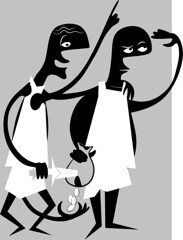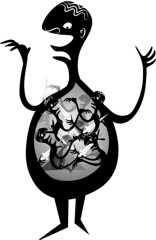But you knew about that already. More to the point: I’ve finally got some NON-free Plato for you! Plato you can pay for! And receive some Plato in exchange! My book is finally honest to gosh in stock at Amazon! After almost two months of not being in stock, despite occasionally shipping, this strikes me as a commercial step up. I trust my friends, mom, and the select, lofty rationalists who ordered and awaited initial copies with familial-Parmenidean serenity have, in due course, received and been pleased. But what about the appetitive masses, unable to regulate their desires and make them friendly to one another, etc? It will never be four weeks from now, the desires think to themselves. But soon it will be two days from now. Soon enough. I could wait two days. That is how desire for a book thinks. Well, now you hasty masses can get my book in, like, two days! So buy it already. Assuming you want it. (And Belle’s! Don’t forget it’s Belle’s book, too. She’s not so shameless about flogging it, mind you. But that doesn’t mean she’s without feeling in the matter.)
But I don’t feel like talking about philosophy tonight. I already did that for hours today. I just got a big stack of art and design and cartoon books. Let’s talk about that. Oh, and I did a bit of research. In my last post, I failed to give Faith Hubley half credit for “Moonbird”, so I went and read the little bit there is about her in Amid Amidi’s Cartoon Modern: Style and Design in 1950s Animation [amazon]. Fun fact: when she got married to John, one of their marriage vows was ‘to make one non-commercial film a year.’ Faith was apparently more determined in that regard than her husband. One of their first collaborations was “A Date With Dizzy” (YouTube – but no credit for Faith!), in which Gillespie’s band fails to come up with a plausible way to advertise ‘instant rope ladder’. It’s a weird clip, all I can say. (But I’ll say a bit more anyway in a moment.)
Moving right along. I just got Wildsville: The Art of Derek Yaniger (Masters of Lowbrow) [amazon] – which is fun, in a Shagish sort of manneristic flat-style big noses in profile and cute chix Frankentiki way. It is what it is. Better, I think, is where it comes from. I just got The Sweetly Diabolic Art of Jim Flora
[amazon]. Ah, this is what I really like. You can see lots of Flora stuff here. Flora is the Picasso of flat style big nose expressionist-antic male figures in profile school. I’m not ashamed to say I might have sort of ripped off his style, in toto, as best as I could manage, to make the illustrations for my own book. This sort of thing:
And this sort of thing:
And this sort of thing:
Are really just this sort of thing. I console myself that I am in excellent company. There’s a line of descent for this style that runs pretty straight right through Flora, on the one hand, and through Hubley in particular, in animation. (The cross-connection is Gene Deitch, who was inspired by Flora’s Jazz covers, in his own jazz stuff, then went to work for Hubley at Storyboard. There is definitely a strong modern jazz thing running through a lot of this.)
And another good book I just got hold of: The Whimsical Work of David Weidman and Also Some Serious Ones [amazon]. Weidman was a background artist at Storyboard and UPA (too bad that Finian’s Rainbow project got killed.) John Hubley gave him his start, and he went on to do lots of beautiful stuff over the decades. OK, here’s a good story that comes out of this one:
For illustrators in the late 1940’s, Norman Rockwell’s style was the archetype, to be either emulated or rebelled against. At Jepson [an art school], the teaching artist who took up the latter charge was Rico Lebrun … Lebrun was at his peak when David Weidman was exposed to him, and the effect was powerful.
“Rico Lebrun was a tremendous influence on me and on a lot of the other GI’s there,” says Weidman. “Lebrun changed our concepts from photo-generating visual images onto paper. We were all going to be illustrators, but most of us, after taking his class, could no longer do that. Our concepts had changed. Ity was like going to a psychologist and re-orienting your basic premises,” Weidman remembers. “If we could have started with him, it wouldn’t have been a problem; we could have grown into it. But we had gone in this other direction and we didn’t want to give it up, because we were comfortable with it. So Lebrun spent most of his time getting rid of Norman Rockwell, who by the way I still like. He has something special to offer. But Lebrun was electric – a small guy, a dynamo. He wanted through the class and everybody shit! It was hard to give up what you had perfected, the visual rendering of what you saw. He had to break us of that.”
The effect was a change in what Weidman calls his “graphic orientation,” a term that he feels compelled to define further. “In using the word ‘graphic’, I’m referring to the elements of line, shape, texture, color, which make up the image on the 2-D surface – in my case, usually a sheet of paper. The use of these elements in a consciously ordered way is what separates the men from the boys!” As it turned out, the experience not only changed Weidman’s concepts, but it left him with a new primary artistic influence. “I learned to appreciate and admire other people’s art, especially Matisse, all the work he’s done. Picasso, Ben Shahn – artists who were working with the graphic elements of image making. But the greatest influence on me was Rico Lebrun.”
Another Lebrun student turns to cartooning.
One reason I find this interesting is that it connects up with a magnificent and now classic five-part screed [start at the bottom and read up], by John “Ren and Stimpy” Krikfalusi, about how UPA ‘flat-style’ animation wrecked animation. Basically, he complains that what Weidman says happened happened. Which isn’t exactly news, but I’ll bet if Krikfalusi sees the Weidman book he’ll say ‘you see! you see!’ He has this decline narrative about how an unfortunate sort of craving for high-brow ‘design’ respect caused animators to forget what animation is capable of, in a technical sense. Not that Krikfalusi is categorically unappreciative. As he notes, he personally launched the retro cartoon avalanche with those fake ads that went with the “Ren and Stimpy Show”. (Whereas John Hubley promised “Instant Rope Ladder”, John Krikfalusi gave us “Log!”. It’s weirdly similar.) It seems to me that, quite apart from the whole ‘no disputing taste’ problem, the Krikfalusi argument is sort of weak. He reasons from the fact that the UPA folks figured out how to make do with only a few in-betweens, whereas Disney needed hundreds, that UPA caused the crap animation of the 60’s, 70’s and 80’s. But it’s hard to believe someone wouldn’t have figured out how to make Yogi Bear look terrible, on the cheap, without watching “Gerald McBoingBoing”. And the flat style has had a glorious, high renaissance in all the “Powerpuffs” and “Foster’s Home” stuff. If you ask me. (Would anyone know how to do this if UPA hadn’t pointed the way?) Funnily enough, I sort of think Krikfalusi’s beef is at bottom with the anti-cartoon animal violence principles espoused by John Hubley. But he makes some good points, too. What do you think? I know he would look at my flat-style, UPA and Flora-inspired stuff and correctly deduce: kid doesn’t know how to draw.
Why do young artists say they like UPA? Because it makes ’em cool. Hipster Emo time. (It’s also easy to fake) It’s like when teenagers discover communism. They think it’s real cool to go against common sense and experience. But then when they meet the real world head on later, they realize it was youthful folly. You’re supposed to grow out of it.
I too fell under the UPA spell for the 3 weeks I wanted to be cool. Then I realized I kept falling asleep during the cartoons. Don’t wait till you’re 30, still drawing flat and it’s too late to learn anything else.
Obviously that’s totally unfair to the likes of Weidman. But it hits a bit close to home in my case. I’ll even throw in a couple of fresh “Squid and Owl” pages prove it.
I think it’s ok to torture cartoon animals, but also not to torture them. You shouldn’t feel obligated either way. What do you think?
And you know what the greatest American electoral political propaganda film of all time is? The Chuck Jones-directed UPA classic, FDR-boosting: Hell-Bent For Election!



{ 4 comments }
Batocchio 09.09.09 at 4:58 pm
Congratulations! Meno’s long been one of my favorites. (And as a cartoon enthusiast, I appreciate the rest of the discussion.)
John Holbo 09.10.09 at 12:58 am
Thanks!
Salient 09.10.09 at 2:56 am
If quantity-of-hyperlinks-in-post were the x-axis and comment-garnering-osity were the y-axis, you have with this post have found the far reaches of the Laffer curve: I got lost chasing all the links and did not come back to the original post. Generalizing this phenomenon, you might say this post suffers from diminishing returns.
e julius drivingstorm 09.10.09 at 3:32 am
I also chased the links, got absorbed in Flora’s works, saw visual similarity with Squid and Owl’s codex homage, and ended up spending several more hours researching 8 jaguar paw. I don’t feel like I wasted my time but this art genre is very unfamiliar to me. I did, however, get my copy of Reason and Persuasion and will start from the beginning as I am going to give it the attention it merits and you will hear back from me. Are those turtles playing checkers on the cover?
Comments on this entry are closed.